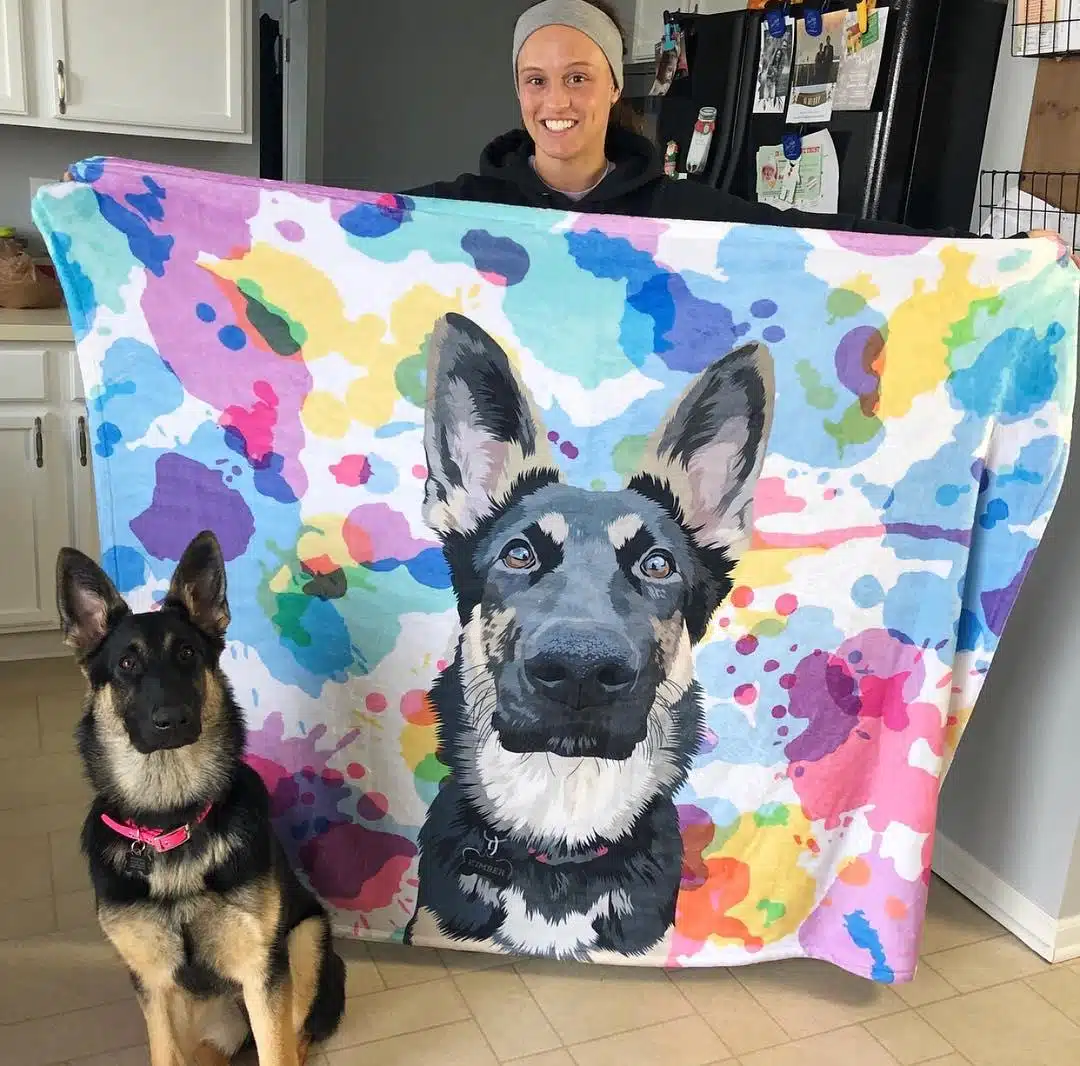Table of Contents
The Crash Course on DIY Dog Ramps for Beds, Stairs, Cars, and Beyond
Credit: Camels & Chocolate
There are numerous reasons why your dog may need a dog ramp — from their tiny stature and skeletal issues to old age and disabilities — but the truth of the matter is that you need one too. A dog ramp can ease your doggo’s climbing up and down the stairs or a piece of furniture, but it also eliminates the need for you to pick them up and carry them around constantly.
A commercial dog ramp that is well-built and reliable can come with a hefty price tag, especially if you want it to be foldable, adjustable, or have any other practical functions. The good news is that you can take care of all that yourself — for a fraction of the cost!
With the help of Alpha Paw, you can make a functional, durable, and sturdy DIY dog ramp that will also be customized to your home’s layout and decor. You’ll be able to make an ideal ramp that will be the perfect addition to any part of your home, as well as your car or yard. Yes, you read that right — outdoor ramps and vehicle ramps can be made at home, too… with proper guidance, that is. Let’s get right to it!
How to Make a Dog Ramp
Before you get to the actual grunt work, you must first cover all your bases and figure out what your dog’s needs are. There’s no point in building a dog ramp that won’t be suitable for your canine or one that they won’t deem secure enough to use.
The One Thing Pet Owners Regret Not Doing Until It’s Too Late
Is your pet safe?
1 in 3 pets will need emergency veterinary treatment each year and it is estimated a pet receives emergency care every 2.5 seconds in the U.S.
The average cost of treating a broken bone in dogs is $2,700. Cancer treatments? Up to $10,000.
It’s why so many pet owners say their biggest regret isn’t the vet bill—it’s not having pet insurance when they needed it most.
Ask yourself: “If an unexpected $5,000 vet bill hit tomorrow, could I afford it?”
If the answer is no, it’s time to get covered.
Take a look at Lemonade. They have a great app that actually works, they have an instant chatbot that is faster and, dare we say it, friendlier than most companies’ “real” customer service and a quick scroll through Reddit will uncover… people are really vibing with this brand.
So go check them out and take a look. It takes less than a minute.
Here’s what you need to consider:
- The size of your dog
- Your goggie’s health
- Your pup’s weight
- Where you will put the ramp
- Whether you will be moving the ramp from one spot to another
- The design of the dog ramp
A Gentle Giant or a Teeny Lap Dog?
Credit: mnn
Dog ramps are not intended only for disabled dogs. Even if your dog is a picture of health, if they are a small or miniature breed, they will benefit from strutting what their momma gave them down their own little runway.
You see, as cute as toy breeds are (I mean, just look at these Teacup Dachshunds!), they are immensely susceptible to skeletal problems. Yorkies, Doxies, Chihuahuas, and many others are prone to back problems that can be severely exacerbated by jumping from overly high surfaces and down endless flights of stairs. Dachshunds, in particular, are genetically predisposed to intervertebral disc disease (IVDD), a condition that can lead to complete paralysis. If you have a Weiner dog, here’s a guide to the best Dachshund ramps.
If you have a big doggo that is well into their senior years, the chances are that they have fallen victim to canine arthritis or have simply lost the springiness in their gait and jump to be able to move about properly. A dog ramp is an excellent aid for aged woofers, too.
Before rushing to the home supply store or your shed for materials, you need to settle on the dimensions of the ramp that you will be fashioned for your furry baby. It goes without saying that you will match the width of the ramp to your pooch’s size and the ramp’s height to that of the object they need to climb, but the length of the ramp will depend on how steep it needs to be.
Small doggies need ramps with a milder incline that they can conquer with ease, but larger doggos can climb up steeper slopes without an issue. The overall health of your pooch should also play a role in settling on the ramp dimensions, and here’s why.
Can Your Pup Go up the Steep Slope?
Credit: diynetwork
The primary purpose of the ramp is to keep your dog’s joints healthy and pain-free. Even if you have a large breed dog, such as a German Shepherd, their osteoarthritis or hip dysplasia may be so advanced that they won’t feel comfortable on a steep ramp.
A dog ramp is also essential for a pup with disabilities, who need a low incline aid. Make sure you also adjust the width of this ramp to your pooch’s wheelchair or any other need they may have. It is always a sound idea to consult with your pup’s vet or physical therapist before you get to the task of building the thingy.

Time to Check the Scales!
You can make a dog ramp from various materials, but the choice will depend on your fluffer’s weight:
- Plastic ramps are lightweight and weather-resistant, but they can only hold pooches that are tiny and lightweight themselves. Still, plastic is not the material of choice for homemade ramps.
- Metallic ramps are sturdier and appropriate for heavier doggos. They tend to weigh a ton and are not the best option if you need to build a portable ramp.
- Wooden ramps, especially those made from plywood, are both lightweight and stable, as well as the most convenient for DIY dog ramps. They are rigid enough to withstand dogs of all sizes, provided that you choose the plywood of appropriate thickness.
What the Ramp Will Be Used For
If you need to make a bed ramp, you can choose the material that can give sufficient support to your doggo and is the most convenient for you to work with. In case you need to build a dog ramp for a deck, your vehicle, or another outdoor use, you have to select the material wisely.
Metallic ramps are likely going to corrode if left in the rain, so they are not the best option if you want to make a long-lasting outdoor ramp. In contrast, they are excellent for vehicles as they can be stored in the trunk and used as needed.
Hardwood is the soundest choice of material for multi-purpose dog ramps. They do well in most weather conditions and are relatively durable. They are also easy to clean in case you need to take them indoors and lean them against your furniture. They are lightweight and portable, so it comes as no surprise that wood is the material of choice for most DIY dog ramps.
Stationary vs. Portable Dog Ramp
You need to determine whether your ramp will stay put in one place — such as over indoor stairs or out on the patio — or whether you need one that you can move from your bed to the sofa to the armchair. Apart from affecting your choice of material, how you use it will influence the design of the ramp itself.
Stationary ramps are easier and quicker to make since they don’t require any add-ons that you need to invest more effort to make. All you need for them is the right material and simple design. Bedside dog ramps are among the easiest to make at home.
Portable ramps require more time and skill. Since ramps are inevitably bulky, if you have to transport them from one place to another, you need to make them foldable or collapsible. Portable ramps for agility training are exceptionally common, as are dog ramps for trucks and dog ramps for RVs.
The Aesthetic Moment
Finally, you need to make sure that your ramp looks good in your home. Granted, if what you need is a vehicle ramp, you can freely skip this step, but indoor ramps affect the overall appearance of your home and are just as important as any other item in it.
Commercial dog ramps have similar designs, but when you are making one yourself, you can play with it and make it unique. You can think in terms of:
- Material
- Color and finish
- Padding or carpeting of the ramp’s walkway
- Decorative legs
- Engravings and inscriptions
- Adding a railing
- Incorporating a storage space on shelves under the plank
How to Build a DIY Dog Ramp Over Stairs
Credit: prettydiyhome
Now that you’ve adequately prepared yourself for this creative endeavor, the time has come to have some fun and build your pooch the ramp of their dreams!
| Skill | Time | Cost |
| Easy
Most of the cutting is rectangular and the tools used are basic |
Two–four hours
Over two days because of the glue-drying time |
$30–$60
Depending on what you already have and what add-ons you include |
What You Need for the Ramp’s Walkway
Any DIY dog ramp making starts with the walkway. In essence, you can make the same walkway for your stair ramp, bed ramp, deck ramp, even a vehicle ramp, and then add different add-ons to make it practical for those different purposes.
IVDD Survivor Story – Hannah & Louis
By now, you’ve settled on your preferred material — in most cases, plywood boards are ideal as they are the easiest to work with at home. The chances are that you already have all the tools needed for working with wood, which makes it all the more convenient.
Here’s what you’ll need for your little project:
- A plywood board for the walkway — go for an ¼ inch thick board or more, depending on the dog’s weight
- Two hardwood side beams
- A pen
- A measuring tape or a ruler
- Saw
- Sandpaper
- A hot glue gun
- The material for carpeting the ramp’s walkway
- A drill
- Some screws
- Paint and brush (optional)
Step 1: Measurement and Cutting
Use the pen to mark the beams with the cutting lines. You already chose the measurements based on the length of your stairs and the incline that is appropriate for your pooch and their needs. Then, saw everything to perfection, and don’t forget to sand the wood afterward to make it as smooth as possible — that will prevent any splinters from piercing through your pup’s skin or yours later on. You should end up with two sides and a walkway custom made for your pooch’s needs.
Step 2: Assembly
Now that you have cut the ramp’s walkway and the sides, you can attach them together. Use your drill to make enough holes and then screw the sides and the walkway together. Avoid gluing these pieces together as that will make the ramp less stable and more likely to break apart pretty soon.
Step 3: Carpeting
Now it’s time to add the carpet on the walkway. This part is essential because your pup’s paws are soft and fuzzy, which is why they could slip on the smooth wooden surface of the ramp. Choose a rough material that would provide a good grip for your dog and prevent slipping.
Use the hot glue gun and glue the carpet onto the walkway. Pay attention to glue the edges of the carpet well — otherwise, your little clutz could trip on them. Leave the hot glue to dry overnight and get back to your little work of art in the morning.
Alternatively, you could skip the carpet and add several parallel beams along the ramp’s walkway. This is a good idea for outdoor ramps, such as those used over stairs on a deck or porch, as the carpet would soak in rainwater and cause the plywood beneath to rot quickly.
Step 4: Affixing
Now that everything is cut, screwed in, and glued together, it’s time to put the ramp over the steps! Use the drill and screws one more time and secure the ramp in place. Double-check to see if anything is wobbly or shaky — if it isn’t, congratulate yourself on a job well done and see how your pooch likes their ramp!
If you’d like to take your DIY dog ramp to the next level, you can opt to paint it an interesting color. You could also get your creative juices flowing and paint several paws along the walkway or write your doggo’s name along the sides of the ramp.
How to Build a DIY Dog Ramp for Bed
Credit: hgtv
When it comes to indoor ramps, especially ones dogs use for climbing up furniture, you have endless options on how to make them eye-catching, beautiful, and practical. Here’s just a fraction of what you could do:
- Add simple legs to hold the ramp upright
- Make adjustable footing so that you can have better control over the ramp’s incline
- Build collapsible legs to make your ramp easier to store
- Create a storage space under the ramp
Here at Alpha Paw, we are obsessed with multifunctional pieces, so we’re going to show you an easy way to transform the ramp discussed above into a handy little bedside cabinet for your bedroom.
What you’ll need:
- Several wooden crates in different sizes — depending on the size of the ramp walkway you choose for the above project
- Hot glue gun
- Drill
- Screws
- A standard cabinet hinge
- Paint (optional)
Step 1: Building the Shelves
You can get the crates at the local market or in your nearest home supply store. Avoid the cardboard ones as they aren’t sturdy enough for a DIY dog ramp. Wooden crates are stable and decorative — we love the country vibe they can give to the place. If you don’t, you can always paint them to make them chic and contemporary.
Arrange them as you see fit, but make sure that they cascade in a way that keeps to the incline you choose for your goggie’s ramp. Next, use the hot glue gun and glue the crates together.
Step 2: Attaching the Walkway
Place the walkway we made before onto the cascading crates. The design of the ramp should be similar to the one on the image above. If you’re happy with how everything looks, you can affix the ramp to the crate shelves. Make sure you make any tweaks to the design now, before you screw the walkway to the supporting shelves.
To secure everything in place, grab your drill, make some holes, and screw the hinge on the top-most shelf/crate. Connect the other side of the hinge to the walkway plank, and your ramp is ready!
Having a hinge gives you more leeway to adjust the incline later on as your pup ages or if you find that the ramp is too steep for them after all. You can add more crates below to decrease the incline or vice versa.
Step 3: The Paint Job
You can paint the finished project before you add it to your bedroom. You can decorate it any way you like to make it fit seamlessly with your bedroom design. The crate shelves are super handy for storing bedding, throws, shams, books, or even your doggo’s leash, collars, and toys!

Dog ramps come in endless shapes and sizes, so if you need more ideas on how to build one for your four-legged friend, check out our takes on:
References
- https://en.wikipedia.org/wiki/Dog_health
- Weitzman, Gary. National Geographic Complete Guide to Pet Health, Behavior, and Happiness: the Veterinarian’s Approach to at-Home Animal Care. National Geographic, 2019.
- Kirkby, Kristin A., and Daniel D. Lewis. “Canine Hip Dysplasia: Reviewing the Evidence for Nonsurgical Management.” Veterinary Surgery, vol. 41, no. 1, 2011, doi:10.1111/j.1532-950x.2011.00928.x.
- Brevitz, Betsy. The Complete Healthy Dog Handbook: The Definitive Guide to Keeping Your Pet Happy, Healthy & Active. Workman Publishing Co., Inc., 2016.

80% of Dogs Develop Arthritis or Joint Pain by 7 Years old – Here’s How to Protect Them
Most of us train our dogs when they are puppies to jump up on furniture. We think it’s harmless (and easier than always lifting them), but for dogs, couches and beds are very high compared to the size of their bodies.
Every time they jump it compresses their back and applies enormous force to their joints.
It’s no wonder that an incredible 80% of dogs experience arthritis or joint pain by only 7 years old.
Luckily, there is a vet-recommended solution.
It’s the PawRamp by Alpha Paw. An adjustable ramp that allows dogs to safely get on and off couches and beds. PawRamp makes joining you in bed or on the couch effortless and fun.
As a bonus, you can use code SAVE35 to get $35 off the PawRamp today.














